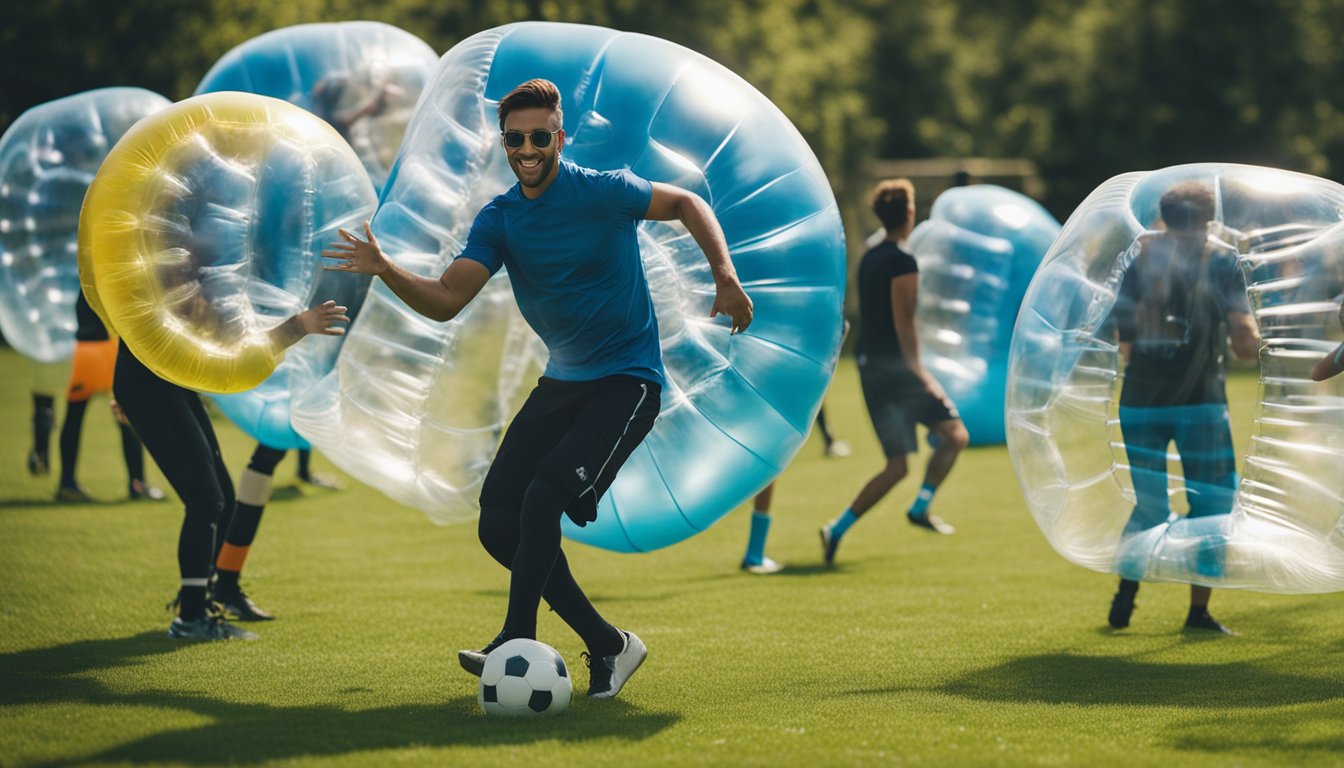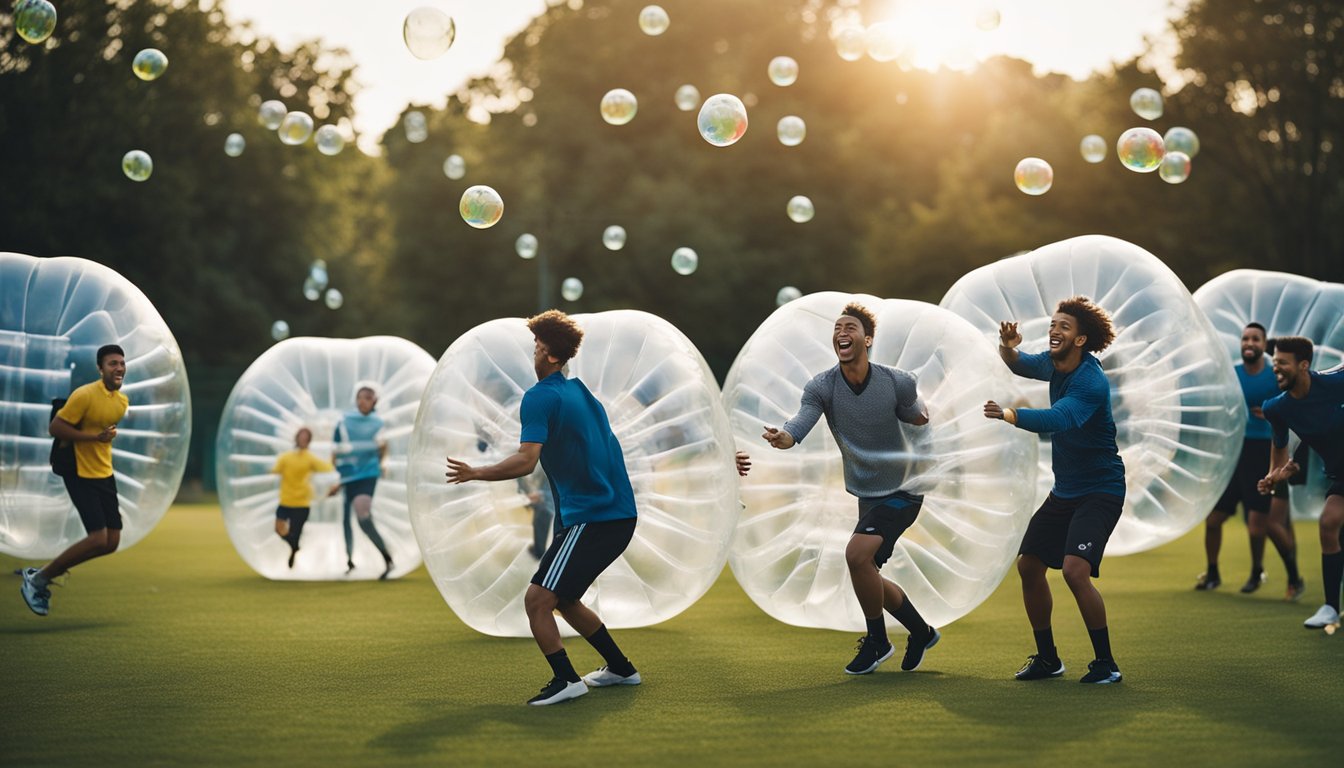Late updated: 29 Nov 2024 10:11
Written by: Emma Saunders
Exploring Bubble Football For Family Fun: A Unique Active Experience
Exploring an activity that combines excitement, laughter, and physical engagement can be challenging, but bubble football offers just that mix for families. Bubble football, known for its blend of fun and safety, is an ideal choice for family outings, providing a unique way to bond. Each player wears an inflatable suit, adding a hilarious twist to moving across the field and trying to score goals.

Families of all ages can enjoy bubble football due to its accessibility and the minimal risk of injury it poses. This sport not only promotes physical activity but also helps build teamwork and communication skills as players coordinate to achieve their objectives while manoeuvring around within the constraints of their bubble suits.
Parents and children alike often find the experience of bubble football to be richly rewarding and filled with laughter. Organising a session is simple, making it a convenient option for a memorable family day out. Ready to discover more about this entertaining and energetic sport?
Key Takeaways
- Bubble football is a safe and fun sport for families.
- Promotes teamwork and communication.
- Easy to organise for a family outing.
Understanding Bubble Football
Bubble football, also known as bubble soccer or zorb football, is an entertaining alternative to traditional football. It involves wearing large inflatable bubbles, adding a unique element of fun and challenge. This engaging activity requires understanding the basics and adhering to safety measures to ensure a secure and enjoyable experience for everyone involved.
Basics of Bubble Football
At its core, bubble football combines the rules of traditional football with the twist of playing inside inflatable bubble suits. These suits encase the upper body, leaving the legs free to run and kick. Matches usually have two teams, each aiming to score goals while bouncing off one another. The unpredictability of movement adds an element of hilarity and style to the game.
Games are generally shorter than standard football matches, lasting around 60 minutes. The rules mirror those of five-a-side football but focus on fun rather than competition. Teams can consist of four to five players, ensuring everyone gets plenty of action. An emphasis is placed on fun, laughter, and the occasional friendly bump rather than strict adherence to conventional football rules.
Equipment and Safety Measures
The primary piece of equipment is the inflatable bubble, a key aspect of the sport. These bubbles cushion players from impacts, allowing them to play safely. It's vital to ensure the bubbles are properly inflated to offer adequate protection against falls and collisions. The bubble suits should fit well and be checked for tears or damage before use.
Safety precautions are essential, especially due to the bouncing and rolling involved. Players should always follow safety guidelines, such as avoiding reckless behaviour and respecting boundaries. Wearing comfortable, sturdy footwear enhances stability and grip. Adhering to these safety measures ensures a safe and enjoyable experience for all participants, making the game a source of laughter and camaraderie.
Enhancing the Experience

To make the most of bubble football, fostering teamwork and communication is essential. Additionally, the sport offers substantial health benefits, making it an enjoyable and rewarding activity for all ages.
Maximising Teamwork and Communication
In bubble football, teamwork and communication are paramount. As players are encased in giant bubbles, visibility and movement can be limited. Effective communication becomes vital. Teams should develop concise signals and verbal cues to coordinate their strategies, ensuring everyone is on the same page.
Team-building exercises can be initiated to enhance these skills. Players can engage in drills that encourage quick, clear communication. This practice helps in refining team coordination and strategy formulation, both crucial to performing well on the field.
Fouls are less common due to the protective nature of the bubbles, but maintaining sportsmanship is as important as ever. By reinforcing positive interactions during gameplay, we can cultivate an atmosphere of fun and camaraderie.
Health Benefits of Playing Bubble Football
Bubble football is not just a fun way to spend an afternoon. It offers significant cardiovascular benefits. The sport requires players to use a combination of agility and energy, resulting in a vigorous cardiovascular workout. This aids in improving overall fitness and energy levels.
The physical activity involved enhances agility. Players must navigate and manoeuvre while encased in the bubble, which sharpens reflexes and coordination. This contributes to better physical health and enjoyment of the sport.
Moreover, the giant bubbles provide safety, reducing the risk of injury and promoting an inviting environment for players of all ages. This encourages more people to engage in the game, making it an inclusive sport for families seeking enjoyable and healthy activities.
Frequently Asked Questions

Engaging in bubble football requires understanding the necessary gear, participant safety, basic rules, and age recommendations. Here, we explore these aspects to make your bubble football experience enjoyable and safe.
What equipment is required to participate in bubble football?
To participate, players wear large inflatable suits known as zorbs. These cover the upper body and face, providing cushioning for falls and bumps. Essential gear includes comfortable athletic attire and sturdy trainers. Venues usually supply the zorbs and other necessary equipment.
Can children participate safely in bubble soccer?
Children can indeed take part safely with the right equipment and supervision. Most organisers offer smaller zorbs designed for younger players, ensuring proper fit and protection. Adult supervision is recommended to ensure safety and compliance with game rules.
What are the rules and objectives of bubble football?
Bubble football follows a similar objective to traditional football — scoring goals against the opposing team. However, players must navigate their movements encased in zorbs, which allows for fun, safe collisions. The rules are generally relaxed, focusing on enjoyment rather than competition.
What safety measures are in place for Zorb football?
Safety is a priority, with zorbs made from durable materials that absorb impact. Organisers conduct pre-game briefings on safe play and emergency protocols. The zorbs are designed to keep players’ heads and bodies protected during collisions and falls.
How does bubble football differ from traditional football?
The most striking difference is the use of zorbs, which restricts arm movement but adds a layer of protection and fun. This variation introduces more physical play, where bouncing off each other is part of the experience, unlike conventional football.
What are the age and health recommendations for bubble football?
While there isn't a strict age limit, participants should generally be over six years old, depending on their physique and coordination. Those with pre-existing medical conditions, especially related to back or neck injuries, should consult a doctor before participating. It's crucial to ensure that everyone involved is in good health to safely enjoy the game.
